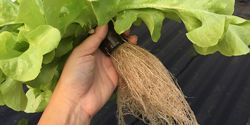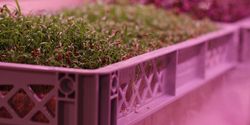Q&A with LettUs Grow Ltd.
Results showed an average uplift in biomass production of 22% for the Aeroponic Rolling Benches, addressing challenges related to resource efficiency and agricultural sustainability.
Renewably powered aeroponic farms can significantly reduce the environmental impact of fresh produce compared to imports, new study finds.
Aeroponic container farms are a new method of farming that use a soilless technique to grow crops in a controlled environment. This method involves suspending the plant roots in a nutrient-rich mist, which helps to optimise crop growth and reduce water usage.
Rehabilitation via vertical farming trialled for the first time in UK prisons
For the first time in the UK, vertical farming will be trialled in a prison setting as part of a strategy to aid rehabilitation by empowering prisoners and helping them develop new skills to reintegrate back into society.
Key Differences Between Aeroponics & Hydroponics
If you're wondering what the differences are between Aeroponics vs. Hydroponics, you're probably not alone. These often misunderstood agricultural practices are set up to be the future of farming, but most people don't know much about them.
AeroFarms Breaks Ground on World's Largest and Most Technologically Advanced Aeroponic Indoor Vertical Farm
Next-generation Model 5 farm to advance leadership in plant science and technology, drive continuous innovation and expand leafy greens business in Mid-Atlantic region.
Readers Choice 2020: Space to Grow, or Grow in Space - How Vertical Farms Could Be Ready to Take-off
Vertical farms with their soil-free, computer-controlled environments may sound like sci-fi, but there is a growing environmental and economic case for them, according to new research laying out radical ways of putting food on our plates.
Taking aeroponics back to its roots: The history of aeroponics and why it matters.
The aeroponic origin story is deeply rooted in space and science fiction. In space, crews must utilise all resources to their fullest potential, reducing, reusing and recycling everything they take with them.
How Science Helps an Indoor Farm
While there are many different techniques with indoor farming, including hydroponics, aeroponics, and aquaponics, all of them have one thing in common - the lack of soil. Instead of using the concept of growing in soil, crops are instead grown in peat moss or coconut husks.
#1 Article for 2018 - Growing with Hydroponics, Aeroponics and Aquaponics
Because hydroponics, aeroponics and aquaponics do not use soil, they can be established indoors in locations that have cold, severe climates. These growing methods can also be used in localities that have poor, sandy soil.
Records 1 to 9 of 9
Featured Product

Maximize Growth and Savings with Cree LED's J Series® LEDs
Cree LED's J Series® LEDs offer a versatile range of solutions for horticulture applications, delivering exceptional performance and efficiency. The J Series 2835 3V N Class Color LEDs are available in 15 vibrant colors with industry-leading efficacy, providing tailored lighting options for plant growth. The J Series JR5050C E Class White LEDs boast the highest efficacy among high-power LEDs, enabling up to 40% system cost savings. For additional flexibility, the J Series JR5050B K Class White LEDs offer best-in-class efficacy with 6V and 30V options. The J Series JB3030C E Class White LEDs provide outstanding 3030 efficiency with a typical output of up to 3.33 PPF/W, while maintaining footprint compatibility with the popular 301B/H. Lastly, the J Series JB2835B G Class White LEDs feature the highest efficacy in the 2835 platform, ensuring optimal performance for horticulture lighting systems.







.jpg)

